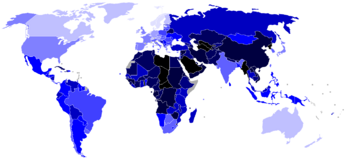Dictatorship
| This article is part of the Politics series |
| Forms of government |
| List of forms of government |
|
| Politics portal |
A dictatorship is usually defined as an autocratic form of government in which the government is ruled by a dictator. It has two possible meanings:
- Roman dictator was a political office of the Roman Republic. Roman dictators were allocated absolute power during times of emergency. Their power was originally neither arbitrary nor unaccountable, being subject to law and requiring retrospective justification. There were no such dictatorships after the beginning of the 2nd century BCE, and later dictators such as Sulla and the Roman Emperors exercised power much more personally and arbitrarily.
- In contemporary usage, dictatorship refers to an autocratic form of absolute rule by leadership unrestricted by law, constitutions, or other social and political factors within the state.
For some scholars, dictatorship is a form of government that has the power to govern without consent of those being governed, while totalitarianism describes a state that regulates nearly every aspect of public and private behavior of the people. In other words, dictatorship concerns the source of the governing power (where the power comes from) and totalitarianism concerns the scope of the governing power (what is the government). In this sense, dictatorship (government without people's consent) is a contrast to democracy (government whose power comes from people) and totalitarianism (government controls every aspect of people's life) corresponds to liberalism (government emphasizes individual right and liberty). Though the definitions of the terms differ, they are related in reality as most of the dictatorship states tend to show totalitarian characteristics. When governments' power does not come from the people, their power is not limited and tend to expand their scope of power to control every aspect of people's life.
Contents |
Postwar Era and the Cold War
In the postwar era, dictatorship became a frequent feature of military government, especially in Latin America, Asia, and Africa. In the case of many African or Asian former colonies, after achieving their independence in the postwar wave of decolonization, presidential regimes were gradually transformed into personal dictatorships. These regimes often proved unstable, with the personalization of power in the hands of the dictator and his associates, making the political system uncertain.
During the Cold War, the United States and the USSR managed to expand or maintain their influence zones by financing paramilitary and political groups and encouraging coups d'état, especially in Africa, that have led many countries to brutal civil wars and consequent manifestations of authoritarianism. In Latin America the threat of either communism or capitalism was often used as justification for dictatorship.
List of dictators in modern times
This is an incomplete list of dictators in modern times.



- Abdullah of Saudi Arabia—Saudi Arabia 2005–present[update][1]
- Sabah Al-Ahmad Al-Jaber Al-Sabah—Kuwait 2006–present[update]
- Idi Amin—Uganda 1971–1979
- Fulgencio Batista—Cuba 1952–1959
- Jean-Bédel Bokassa—Central African Republic 1966–1979
- Omar Bongo—Gabon 1967–present[update]
- Leonid Brezhnev—USSR 1968–1982
- Nicolae Ceausescu—Romania 1967–1989
- Blaise Compaoré—Burkina Faso 1987–present[update]
- Porfirio Diaz—Mexico 1876–1911
- Engelbert Dollfuss—Austria 1933–1934
- François Duvalier—"Papa Doc"-Haiti 1957-1971
- Jean Claude Duvalier—"Baby Doc"-Haiti 1971-1986
- Francisco Franco Bahamonde—Spain 1939–1975
- Alberto Fujimori—Peru 1990–2000
- Leopoldo Galtieri–Argentina 1981–1982
- Klement Gottwald—Czechoslovakia 1948–1953
- Haile Selassie–Ethiopia 1930–1974
- Adolf Hitler—Germany 1933–1945
- Enver Hoxha—Albania 1944–1985
- Erich Honecker—German Democratic Republic 1971–1989
- Hu Jintao—People's Republic of China 2002–present[update]
- Saddam Hussein—Iraq 1979–2003
- Kim Il-Sung—North Korea 1948–1994
- Wojciech Jaruzelski—Poland 1981–1989
- Kim Jong Il—North Korea 1994–present[update]
- Hamad ibn Isa Al Khalifah—Bahrain 1999–present[update]
- Islom Karimov-Uzbekistan 1991–present[update]
- Ayatollah Khomeini—Iran 1979–1989
- Nikita Khrushchev–Soviet Union 1953–1964
- Alexander Lukashenko—Belarus 1994–present[update]
- Mao Zedong—China 1949–1976
- Ferdinand Marcos—Philippines 1972–1986
- Mengistu Haile Mariam—Ethiopia 1977–1991
- Ioannis Metaxas—Greece 1936–1941
- Hosni Mubarak—Egypt 1981–present[update]
- Robert Mugabe—Zimbabwe 1980–present[update]
- Pervez Musharraf—Pakistan 1998–2008
- Benito Mussolini—Italy 1922–1943
- Miklos Horthy de Nagybánya—Hungary 1920–1944
- Francisco Macías Nguema—Equatorial Guinea 1968–1979
- Teodoro Obiang Nguema—Equatorial Guinea 1979–present[update]
- Denis Sassou Nguesso—Republic of the Congo 1979–present[update]
- Manuel Noriega—Panama 1983–1989
- Juan Carlos Onganía—Argentina 1966–1973
- Henri Philippe Pétain—France 1940–1944
- Simon Petlyura—Ukraine 1919-1926
- Józef Pilsudski—Poland 1926–1935
- Augusto Pinochet—Chile 1973–1990
- Pol Pot—Cambodia 1975–1978
- Miguel Primo de Rivera—Spain 1923–1930
- Efraín Ríos Montt—Guatemala 1982–1983
- Gustavo Rojas Pinilla—Colombia 1953–1957
- Muammar Abu Minyar al-Qadhafi—Libya 1969–present[update]
- Vidkun Quisling—Norway 1940–1945
- António de Oliveira Salazar—Portugal 1932–1968
- Antonio Lopez de Santa Anna—Mexico 1839-1845
- Mobutu Sese Seko—Zaire 1965–1997
- Anastasio Somoza Debayle—Nicaragua 1967-1972, 1974-1979
- Anastasio Somoza García—Nicaragua 1937-1947, 1950-1956
- Luis Somoza Debayle—Nicaragua 1956-1963
- Joseph Stalin—USSR 1924–1953
- Alfredo Stroessner—Paraguay 1954–1989
- Suharto—Indonesia 1968–1998
- Sukarno—Indonesia 1949–1968
- Than Shwe—Myanmar 1992–present[update]
- Jozef Tiso—Slovakia 1939–1944
- Josip Broz Tito—Yugoslavia 1945–1980
- Rafael Trujillo (Rafael Leonidas Trujillo y Molina)—Dominican Republic
- Jorge Rafael Videla–Argentina 1976–1981
- Todor Zhivkov—Bulgaria 1954–1989
- Ali Khamenei—Iran 1989–present[update]
- General Zia-ul-Haq—Pakistan 1976–1988
Dictatorships in fiction
In fiction, dictatorship has sometimes been portrayed as the political system of choice for controlling dystopian societies, such as in:
- Big Brother in George Orwell's Nineteen Eighty-Four
- Yevgeny Zamyatin's We
- Fritz Leiber's Ill Met in Lankhmar
- Ray Bradbury's Fahrenheit 451
- Chancellor Adam Susan (called Sutler in the filmed version) in V For Vendetta
- Chancellor Palpatine (later The Emperor) in the Star Wars trilogies.
- The Wizard in L. Frank Baum's The Wonderful Wizard of Oz
See also
- Absolute monarchy
- Totalitarianism
- Plutocracy
- Kleptocracy
- Generalissimo
- Maximum Leader
- Military rule
- Military dictatorship
- Police state
- Elective dictatorship
- Constitutional dictatorship
- Dictator
- Tyrant
- Despotism
Further reading
- Friedrich, Carl J.; Brzezinski, Zbigniew K. (1965). Totalitarian Dictatorship and Autocracy (2nd ed. ed.). Praeger.
- Bueno de Mesquita, Bruce; Alastair Smith, Randolph M. Siverson and James D. Morrow (2003). The Logic of Political Survival. The MIT Press. ISBN 0-262-63315-9.
References
|
|||||||||||